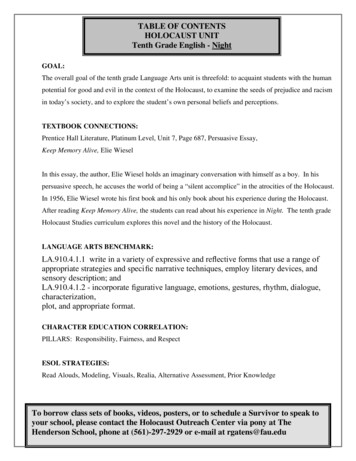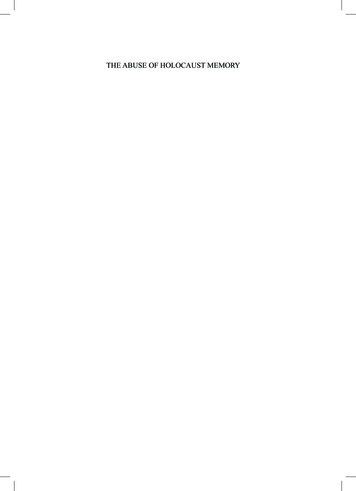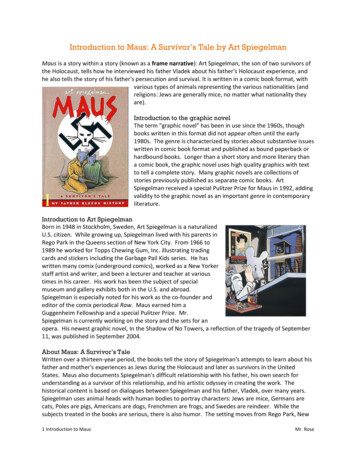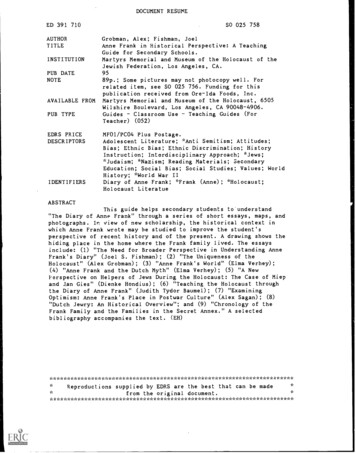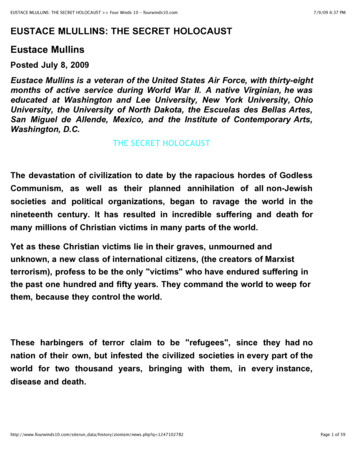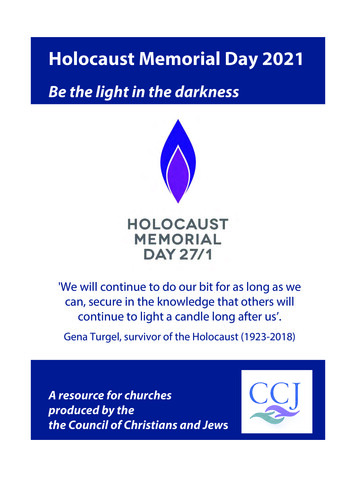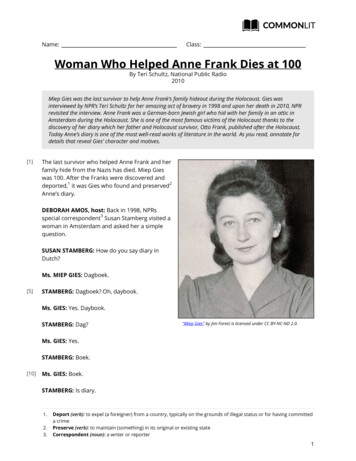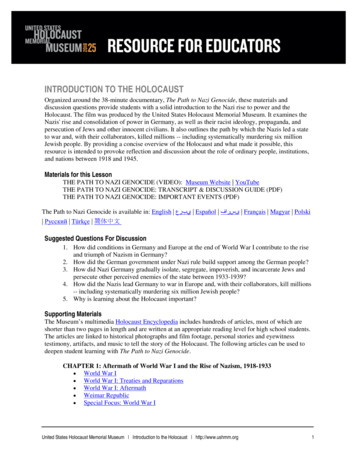
Transcription
INTRODUCTION TO THE HOLOCAUSTOrganized around the 38-minute documentary, The Path to Nazi Genocide, these materials anddiscussion questions provide students with a solid introduction to the Nazi rise to power and theHolocaust. The film was produced by the United States Holocaust Memorial Museum. It examines theNazis' rise and consolidation of power in Germany, as well as their racist ideology, propaganda, andpersecution of Jews and other innocent civilians. It also outlines the path by which the Nazis led a stateto war and, with their collaborators, killed millions -- including systematically murdering six millionJewish people. By providing a concise overview of the Holocaust and what made it possible, thisresource is intended to provoke reflection and discussion about the role of ordinary people, institutions,and nations between 1918 and 1945.Materials for this LessonTHE PATH TO NAZI GENOCIDE (VIDEO): Museum Website YouTubeTHE PATH TO NAZI GENOCIDE: TRANSCRIPT & DISCUSSION GUIDE (PDF)THE PATH TO NAZI GENOCIDE: IMPORTANT EVENTS (PDF)The Path to Nazi Genocide is available in: English يبرع Español یسراف Français Magyar Polski Русский Türkçe 简体中文Suggested Questions For Discussion1. How did conditions in Germany and Europe at the end of World War I contribute to the riseand triumph of Nazism in Germany?2. How did the German government under Nazi rule build support among the German people?3. How did Nazi Germany gradually isolate, segregate, impoverish, and incarcerate Jews andpersecute other perceived enemies of the state between 1933-1939?4. How did the Nazis lead Germany to war in Europe and, with their collaborators, kill millions-- including systematically murdering six million Jewish people?5. Why is learning about the Holocaust important?Supporting MaterialsThe Museum’s multimedia Holocaust Encyclopedia includes hundreds of articles, most of which areshorter than two pages in length and are written at an appropriate reading level for high school students.The articles are linked to historical photographs and film footage, personal stories and eyewitnesstestimony, artifacts, and music to tell the story of the Holocaust. The following articles can be used todeepen student learning with The Path to Nazi Genocide.CHAPTER 1: Aftermath of World War I and the Rise of Nazism, 1918-1933 World War I World War I: Treaties and Reparations World War I: Aftermath Weimar Republic Special Focus: World War IUnited States Holocaust Memorial Museum Introduction to the Holocaust http://www.ushmm.org1
CHAPTER 2: Building a National Community, 1933-1936 Foundations of the Nazi State Dictatorship under the Third Reich Third Reich Nazi Racial Ideology Nuremberg Laws Rallying the NationCHAPTER 3: From Citizen to Outcast, 1933-1938 Early Stages of Persecution The First Concentration Camps Kristallnacht Defining the EnemyCHAPTER 4: World War II and the Holocaust, 1939-1945 World War II in Europe Persecution and Murder of Jews Ghettos Mobile Killing Squads (Einsatzgruppen) Killing Centers Additional Victims of Nazi Persecution Death Marches LiberationThe Holocaust Museum website includes a timeline of key events from World War I through theHolocaust and its aftermath. This is a simple tool to help fill in context for the narrative presented in ThePath to Nazi Genocide.For teachers and students seeking a more concise overview of the Holocaust than that presented in ThePath to Nazi Genocide, consider the animated map, “World War II and the Holocaust.” It is one ofseveral animated maps that illustrate the scope and impact of the Holocaust.Finally, the Museum offers guidance on teaching about the Holocaust, including guidelines, resourcematerials, and information about professional development opportunities.United States Holocaust Memorial Museum Introduction to the Holocaust http://www.ushmm.org2
THE PATH TO NAZI GENOCIDE: IMPORTANT EVENTSChapter 1: Aftermath of World War I and the Rise of Nazism, 1918-1933How did conditions in Germany and Europe at the end of World War I contribute to the rise and triumphof Nazism in Germany? The Treaty of Versailles was signed in France, June 1919: Many Germans were shocked andangered over the terms of the treaty, which deprived Germany of any significant military power.Having lost World War I, Germany had to accept full responsibility for starting the war, payheavy reparations, and forfeit 13 percent of its territory. The ratification of the Weimar Constitution in August 1919: In the wake of losing World WarI, a national assembly drafted a democratic constitution. This was a new and unfamiliar form ofgovernment for Germans. Fearing the unknown, the delegates agreed to the inclusion of Article48. In case of state emergency, Article 48 allowed the government to rule by presidential decreeand to suspend basic rights and constitutional protections of individuals without parliamentaryconsent. Inflation and the world economic crisis: In order to finance World War I, the Germangovernment sold bonds. After the Treaty of Versailles, the government printed paper money topay back the bondholders and make reparation payments. These and other measures generated acatastrophic inflation that peaked in 1923. After a short period of stability, the US stock marketcrash of 1929 and the world economic crisis that followed forced German banks to close andunemployment to skyrocket. Hitler is imprisoned at Landsberg Prison in 1924: Hitler tried to overthrow the government inNovember 1923. His trial for high treason in 1924 brought him additional fame and followers. Heused his jail time during the rest of that year to dictate his political ideas in a book entitled MeinKampf (My Struggle). President Hindenburg appointed Hitler as Chancellor in January 1933: The GermanNationalists and the traditional elites felt they needed the popular support that the Nazis couldmobilize in order to create a functioning government and that they could better control Hitler if hewere a part of the coalition government. President Hindenburg appointed Hitler as Chancellor andthe Nazi Party began to assume control of the German state. The Reichstag building torched on February 27, 1933: A lone arsonist set fire to theReichstag, Germany’s parliament building, just a month after Hitler became Chancellor. TheNazis and their Nationalist coalition partners demanded emergency legislation, and stokingpopular fears, claimed that the arson signaled the beginning of a Communist uprising. Convincedby these arguments, President Hindenburg invoked Article 48, and the Nazi-Nationalistgovernment issued the Reichstag Fire Decree. It suspended all basic civil rights and constitutionalprotections, providing the basis for arbitrary police action and restricting access to alternativesources of information. German police and Nazi paramilitary groups targeted, terrorized, andindefinitely incarcerated political opponents. Government decrees severely restricted freedoms ofthe press, the creative arts, literature, and theater. Many Germans willingly accepted or activelysupported these extreme measures in favor of order and security. Right-wing propaganda anddemonstrations played on fears of a Communist revolution spreading from the Soviet Union.United States Holocaust Memorial Museum The Path To Nazi Genocide: Important Events http://www.ushmm.org1
Chapter 2: Building a National Community, 1933-1936How did the German government under Nazi rule build support among the German people? Hindenburg’s Death in August 1934: After securing agreement from the army, Hitler abolishedthe office of President, declaring himself Führer and Reich Chancellor, leader of the nation, andhead of the government. No longer did government or military officials swear allegiance to aconstitution; they now swore an oath to Hitler as the supreme leader of the German nation. Remilitarization: Huge public works projects, such as a network of highways (autobahn),strengthened the economy and facilitated the remilitarization of Germany. These projects and theemployment they spawned encouraged hope for the future and strengthened popular faith in theNazi government. In 1935, Germany openly defied the 1919 Treaty of Versailles by reinstitutingmilitary conscription and full rearmament. Introduction of Race Laws: In Nazi ideology, “superior” races must battle “inferior” races or becorrupted by them. Such racist ideas were taught in schools. The Nazis labeled groups that hadendured centuries of prejudice and hostility—such as Jews, Slavs, blacks, and Roma (also calledGypsies)—as “racially inferior.” The German government enacted hundreds of laws to define,segregate, and impoverish German Jews. In September 1935, the Nazi Party gathered inNuremberg for its annual rally. New race laws were introduced by Hitler and read by ParliamentPresident Hermann Göring. Most important, the decrees stripped Jews of German citizenship andthe rights guaranteed by citizenship. By 1938, Jews were isolated and segregated from Germansociety, eliminated from most opportunities to earn a living. German Jews became “foreigners”blamed for Germany’s suffering under the parliamentary republic and depicted as waiting toundermine Germany again. German Jews were excluded and were labeled as “Germany’sMisfortune.”Chapter 3: From Citizen to Outcast, 1933-1938How did Nazi Germany gradually isolate, segregate, impoverish, and incarcerate Jews and persecute otherperceived enemies of the state between 1933 and 1939? 1933 Boycott of Jewish Businesses: On April 1, 1933, the Nazis carried out the first nationwide,planned action against Jews in Germany: a boycott of Jewish businesses. Signs reading “Don’tBuy from Jews” and “The Jews Are Our Misfortune” were posted on local businesses. Though oflimited success and lasting just a day, the boycott marked the beginning of a nationwidecampaign by the Nazi Party against the entire German Jewish population. Invasion of Austria: In March 1938, German troops moved into neighboring Austria. Germanyshredded another provision of the Versailles Treaty, as Hitler’s homeland was incorporated intoGermany. Kristallnacht—“Night of Broken Glass”: On November 9-10, 1938, the Nazi Partyorchestrated an outbreak of anti-Jewish violence throughout greater Germany. Nazi thugs killedat least 91 Jews during the violence and vandalized over 7,000 Jewish-owned businesses.Germans cynically referred to the violence as Kristallnacht— “Night of Broken Glass”—for theshattered windows of Jewish-owned stores that littered the streets.Chapter 4: World War II and the Holocaust, 1939-1945How did the Nazis lead Germany to war in Europe and, with their collaborators, kill millions—includingsystematically murdering six million Jewish people? Invasion of Poland: Until 1939, Great Britain and France sought to avoid war by makingconcessions to German expansionist demands. However, on September 1, 1939, a massiveGerman force invaded and conquered Poland within one month. Two days later, after Germanyfailed to respond to their demands to withdraw, Britain and France declared war on Germany.World War II had begun.United States Holocaust Memorial Museum The Path To Nazi Genocide: Important Events http://www.ushmm.org2
Invasion of Western Europe: In April–June 1940, Germany occupied Denmark and Norway. InMay, the German armed forces attacked France, the Netherlands, Luxembourg, and Belgium. InJune, Paris fell. The French acknowledged defeat and signed an armistice. The swift andunexpected victory over France avenged Germany’s defeat and humiliation in World War I,propelling Hitler to a new level of popularity and trust among the German people.Invasion of the Soviet Union: In June 1941, the German Army—with more than three millionsoldiers—invaded the Soviet Union to wage a war of annihilation that targeted tens of millions ofcivilians. Also, this invasion meant a million more Jews under Nazi control. German authoritiesdeclared Communist officials and party members as lethal enemies and killed them outright in thetens of thousands. After September 1941, the German occupation authorities deliberately reducedfood rations to Soviet prisoners of war and civilians in the Soviet cities below survival levels,causing the death of millions of Soviet soldiers and civilians by starvation, exposure, andassociated disease. In addition, German SS and police shot hundreds of thousands of captured anddisarmed Soviet soldiers.Establishment of Ghettos: Under conditions of war and military occupation, the Nazi regimepursued its political and racial goals with more radical measures. German authorities exploitedexisting anti-Jewish attitudes among Eastern European populations. German authoritiessegregated those identified as Jews from the non-Jewish population by forcing them into tightlypacked areas called ghettos. Jews in the larger ghettos were imprisoned behind brick walls andbarbed wire.The “Final Solution”: In July 1941, Hermann Göring—Hitler’s second in command—authorized all necessary preparations for the “final solution of the Jewish question” in Germancontrolled Europe. The Nazis established five killing centers in Poland: Auschwitz, Belzec,Chelmno, Sobibor, and Treblinka. Unlike concentration camps, which served primarily asdetention and labor centers, killing centers were created for the purpose of efficient massmurder. Mass deportations of Jews from occupied Europe to the killing centers began in theautumn of 1941.The United States enters the War: On December 7, 1941, the Japanese Imperial Naval AirService carried out a surprise attack on the U.S. Naval Base at Pearl Harbor, Hawaii. Eight U.S.Navy battleships were damaged, four of which were sunk along with other smaller vessels. 188U.S. aircraft were destroyed; 2,403 Americans were killed and 1,178 others were wounded. Thenext day, December 8, the United States declared war on Japan, followed by Germany’sdeclaration of war on the United States on December 11.Allies discover and liberate the concentration camps: The Western Allies launched the largestamphibious assault in history on the northern coast of France at Normandy on June 6, 1944. TheAllied invasion of Germany started with the Western Allies crossing the River Rhine thefollowing March 1945. As Allied troops moved across Europe, they began to encounter tens ofthousands of concentration camp prisoners. Moving from the east, the Soviet Red Army forcesliberated the Auschwitz concentration camp and killing center facility on January 27, 1945. In thefollowing months, the Soviets liberated additional camps in the Baltic states and in Poland as wellas Stutthof, Sachsenhausen, and Ravensbrück concentration camps in Germany. U.S. forcesliberated the Buchenwald concentration camp near Weimar, Germany, on April 11, 1945.American forces liberated more than 20,000 prisoners at Buchenwald. They also liberated DoraMittelbau, Flossenbürg, Dachau, and Mauthausen. British forces liberated concentration camps innorthern Germany. They entered the Bergen-Belsen concentration camp, near Celle, in mid-April1945. Some 60,000 prisoners, most in critical condition because of a typhus epidemic, were foundalive. More than 10,000 of them died from the effects of malnutrition or disease within a fewweeks of liberation.Germany surrenders: Adolf Hitler committed suicide in his bunker in Berlin on April 30, 1945.A week later, on May 7, 1945, Germany surrendered to the Allies, bringing to an end the conflictin Europe. General Alfred Jodl, representing the German High Command, signed theUnited States Holocaust Memorial Museum The Path To Nazi Genocide: Important Events http://www.ushmm.org3
unconditional surrender of both eastern and western German forces in Reims, France; thesurrender took effect the next day.Jewish life in Europe after the Holocaust: For the survivors, returning to life as it had beenbefore the Holocaust was impossible. Jewish communities no longer existed in much of Europe.When people tried to return to their homes from camps or hiding places, they found that, in manycases, their homes had been looted or taken over by others. Returning home was also dangerous.After the war, anti-Jewish riots broke out in several Polish cities. Many survivors ended up indisplaced persons' (DP) camps set up in western Europe under Allied military occupation at thesites of former concentration camps .There they waited to be admitted to places like the UnitedStates, South Africa, or Palestine. At the end of 1946, the number of Jewish DPs is estimated at250,000.United States Holocaust Memorial Museum The Path To Nazi Genocide: Important Events http://www.ushmm.org4
THE PATH TO NAZI GENOCIDE: TRANSCRIPT & DISCUSSION GUIDEThis 38-minute film examines the Nazis’ rise and consolidation of power in Germany. Using rarefootage, the film explores their ideology, propaganda, and persecution of Jews and other victims. It alsooutlines the path by which the Nazis and their collaborators led a state to war and to the murder ofmillions of people. By providing a concise overview of the Holocaust and those involved, this resourceis intended to provoke reflection and discussion about the role of ordinary people, institutions, andnations between 1918 and 1945.This film is intended for adult viewers, but selected segments may be appropriate for youngeraudiences.This film was produced by the United States Holocaust Memorial Museum. It contains materialprotected by copyright and all rights are reserved. This film may not be reproduced and use is limited toeducational purposes only.Film ChaptersPrologue (Starts at 00:00)Aftermath of World War I and the Rise of Nazism, 1918–1933 (Starts at 00:58)Building a National Community, 1933–1936 (Starts at 12:22)From Citizens to Outcasts, 1933–1938 (Starts at 18:12)World War II and the Holocaust, 1939–1945 (Starts at 24:34)Sources and Credits (Starts at 37:25)This film was made possible by generous support from Dr. Donald and Sue Hecht, the Bernice andMilton Stern Foundation, the Louis and Henrietta Blaustein Foundation, and the May FamilyEndowment for Civic Responsibility.CHAPTER 1: Aftermath of World War I and the Rise of Nazism, 1918-1933In the aftermath of World War I, Germans struggled to understand their country’s uncertain future.Citizens faced poor economic conditions, skyrocketing unemployment, political instability, and profoundsocial change. While downplaying more extreme goals, Adolf Hitler and the Nazi Party offered simplesolutions to Germany’s problems, exploiting people’s fears, frustrations, and hopes to win broad support.Discussion QuestionHow did conditions in Germany and Europe at the end of World War I contribute to the rise and triumphof Nazism in Germany?TranscriptNARRATOR:Paris, 1900. More than fifty million people from around the world visited the Universal Exposition—aworld’s fair intended to promote greater understanding and tolerance among nations, and to celebrate thenew century, new inventions, exciting progress. The 20th century began much like our own—with hopeUnited States Holocaust Memorial Museum The Path to Nazi Genocide: Transcript & Discussion Guide http://www.ushmm.org1
that education, science and technology could create a better, more peaceful world. What followed soonafter were two devastating wars.TEXT ON SCREEN:The Path to Nazi GenocideNARRATOR:The first “world war,” from 1914 to 1918, was fought throughout Europe and beyond. It became knownas “the war to end all wars.” It cast an immense shadow on tens of millions of people. “This is not war,”one wounded soldier wrote home. “It is the ending of the world.” Half of all Frenchmen aged 20 to 32 atwar’s outbreak were dead when it was over. More than one third of all German men aged 19 to 22 werekilled. Millions of veterans were crippled in body and in spirit. Advances in the technology of killingincluded the use of poison gas. Under the pressure of unending carnage, governments toppled and greatempires dissolved. It was a cataclysm that darkened the world’s view of humanity and its future. WinstonChurchill said the war left “a crippled, broken world.”TEXT ON SCREEN:Aftermath of World War I and the Rise of Nazism, 1918-1933NARRATOR:The humiliation of Germany’s defeat and the peace settlement that followed in 1919 would play animportant role in the rise of Nazism and the coming of a second “world war” just 20 years later. Whatshocked so many in Germany about the treaty signed near Paris, at the Palace of Versailles, was that thevictors dictated a future in which Germany was deprived of any significant military power. Germany’sterritory was reduced by 13%. Germany was forced to accept full responsibility for starting the war and topay heavy reparations. To many, including 30-year old former army corporal Adolf Hitler, it seemed thecountry had been “stabbed in the back”—betrayed by subversives at home and by the government whoaccepted the armistice. In fact, the German military had quietly sought an end to the war it could nolonger win in 1918. “It cannot be that two million Germans should have fallen in vain,” Adolf Hitler laterwrote. “We demand vengeance!”Many veterans and other citizens struggled to understand Germany’s defeat and the uncertain future.Troops left the bloody battlefields and returned to a bewildering society. A new and unfamiliardemocratic form of government—the Weimar Republic—replaced the authoritarian empire andimmediately faced daunting challenges. Thousands of Germans waited in lines for work and food in theearly 1920s. Middle class savings were wiped out as severe inflation left the currency worthless. Someburned it for fuel. Economic conditions stabilized for a few years, then the worldwide depression hit in1929. The German banking system collapsed, and by 1930 unemployment skyrocketed to 22%. In acountry plagued by joblessness, embittered by loss of territory, and demoralized by ineffectivegovernment, political demonstrations frequently turned violent. Many political parties had their ownparamilitary units to attack opponents and intimidate voters. In 1932, ninety-nine people were killed inthe streets in one month. Right–wing propaganda and demonstrations played on fears of a Communistrevolution spreading from the Soviet Union.New social problems emerged from the impact of rapid industrialization and the growth of cities.Standards of behavior were changing. Crime was on the rise. Sexual norms were in flux. For the firsttime, women were working outside the home in large numbers, and the new constitution gave women theright to vote. Germany’s fledgling democracy was profoundly tested by the crumbling of old values andfears of what might come next. Adolf Hitler had been undisputed leader of the National Socialist GermanWorkers Party—known as Nazis—since 1921. In 1923, he was imprisoned for trying to overthrow thegovernment. His trial brought him fame and followers. He used the jail time to dictate his political ideasUnited States Holocaust Memorial Museum The Path to Nazi Genocide: Transcript & Discussion Guide http://www.ushmm.org2
in a book, Mein Kampf—My Struggle. Hitler’s ideological goals included territorial expansion,consolidation of a racially pure state, and elimination of the European Jews and other perceived enemiesof Germany. He served only a short jail sentence, and after the ban was lifted on his National SocialistParty, Hitler and his followers rejoined the battle in the streets and in the countryside.The Nazi Party recruited, organized, and produced a newspaper to spread its message. Whiledownplaying more extreme Nazi goals, they offered simple solutions to Germany’s problems, exploitingpeople’s fears, frustrations, and hopes. In the early 1930s, the frequency of elections was dizzying. Sowas the number of parties and splinter groups vying for votes. Hitler proved to be a charismaticcampaigner and used the latest technology to reach people. The Nazi Party gained broad support,including many in the middle class—intellectuals, civil servants, students, professionals, shopkeepers andclerks ruined by the Depression. But the Nazis never received more than 38% of the vote in a freenational election. No party was able to win a clear majority, and without political consensus, successivegovernments could not effectively govern the nation.Adolf Hitler was not elected to office and he did not have to seize power. He was offered a deal just as theNazis started to lose votes. In January 1933, when the old war hero, President Paul von Hindenburg,invited Hitler to serve as Chancellor in a coalition government, the Nazis could hardly believe their luck.The Nazis were revolutionaries who wanted to radically transform Germany. The conservative politiciansin the new Cabinet didn’t like or trust Hitler, but they liked democracy even less, and they saw the leftistparties as a bigger threat. They reached out to the Nazis to help build a majority in Parliament. They wereconfident they could control Hitler. One month later, when arson gutted the German parliament building,Hitler and his nationalist coalition partners seized their chance. Exploiting widespread fears of acommunist uprising, they blamed Communists for the fire, and declared emergency rule. PresidentHindenburg signed a decree that suspended all basic civil rights and constitutional protections, providingthe basis for arbitrary police actions.The new government’s first targets were political opponents. Under the emergency decree, they could beterrorized, beaten and held indefinitely. Leaders of trade unions and opposition parties were arrested.German authorities sent thousands, including leftist members of Parliament, to newly establishedconcentration camps. Despite Nazi terror and brutal suppression of their opponents, many Germancitizens willingly accepted or actively supported these extreme measures in favor of order and security.Many Germans felt a new hope and confidence in the future of their country with the prospect of a bold,young charismatic leader. Nazi propaganda chief Joseph Goebbels planned to win over those who werestill unconvinced.GOEBBELS [speaking German]:One must govern well, and for good government one must also practice good propaganda. They worktogether. A good government without propaganda is not more possible than good propaganda without agood government.NARRATOR:Hitler spoke to the SA, his army of storm troopers.HITLER [speaking German]:Germany has awakened! We have won power in Germany. Now we must win the German people.United States Holocaust Memorial Museum The Path to Nazi Genocide: Transcript & Discussion Guide http://www.ushmm.org3
CHAPTER 2: Building a National Community, 1933-1936With the rise of support for the Nazi Party in the 1920s and early 1930s, President Paul von Hindenburginvited Hitler to serve as Chancellor in a coalition government. After Hindenburg’s death, Hitler declaredhimself Führer and Reich Chancellor, leader of the nation and head of the government. The Nazi Partyboosted the economy's recovery and national morale with huge public works projects for the unemployedand with open defiance of the Treaty of Versailles. They were delivering on their promises to restore andstrengthen the nation. Their achievements encouraged many people to overlook, or even to support,radical Nazi policies.Discussion QuestionHow did the German government under Nazi rule build support among the German people?TranscriptTEXT ON SCREEN:Building a “National Community,” 1933-1936NARRATOR:The ceremonial reopening of Parliament, orchestrated by Joseph Goebbels, aimed to link the Hitlergovernment to Germany’s imperial past and portray the Nazis as saviors of the nation’s future. The eventwas carefully staged to reassure the German establishment, including the military, that Hitler wouldrespect their traditions. Nazi–controlled newsreels then gave the impression that the Army supported thenew government. Though Hitler walked behind longtime President Hindenburg for now, the newchancellor would soon be Germany’s absolute dictator.NEWSREEL VOICEOVER:Today was dedicated to the New Germany. And more than one hundred thousand schoolchildren stood,shoulder to shoulder, as the car bearing the aged President and the Chancellor proceeded through thecrowd to the speaker’s stand. Whether you agree with his doctrines or not, it must be admitted that theleadership of Hitler has united the German people for the first time since the war. Their almost fanaticalenthusiasm is a marvel to the entire world NARRATOR:Hindenburg remained President until his death in August 1934. With Hindenburg gone, Hitler, byagreement with the army, abolished the office of President, declaring himself Führer and ReichChancellor, leader of the nation and head of the government. Now there was no authority above or besidehim. Immediately, the armed forces swore an oath of allegiance to Adolf Hitler.GERMAN ARMED FORCES [taking oath in German]:I swear by God this sacred oath to the Führer Adolf Hitler to render unconditional obedience NARRATOR:All civil servants, including teachers and police, members of parliament and the judiciary, swore an oathof loyalty—not to any constitution—but to Hitler as Führer of the German nation. The economy hadreached rock bottom when the Nazis came to power. They boosted its recovery with huge public worksprojects for the unemployed.NAZI NEWSREEL VOICEOVER [speaking German]:A half million folk comrades have gone back to work this year. Since the takeover of power,unemployment has fallen by more than half.United States Holocaust Memorial Museum The Path to Nazi Genocide: Transcript & Discussion Guide http://www.ushmm.org4
NARRATOR:Hitler christened new autobahns triumphantly in a display of national will that would unite the countryand facilitate the secret expansion of Germany’s armed forces. In 1935, Germany openly defied the 1919Treaty of Versailles by
The articles are linked to historical photographs and film footage, personal stories and eyewitness testimony, artifacts, and music to tell the story of the Holocaust. The following articles can be used to deepen student learning with . The Path to Nazi Genocide. CHAPTER 1: Aftermath of World War I and the Rise of Nazism, 1918-1933 World .


